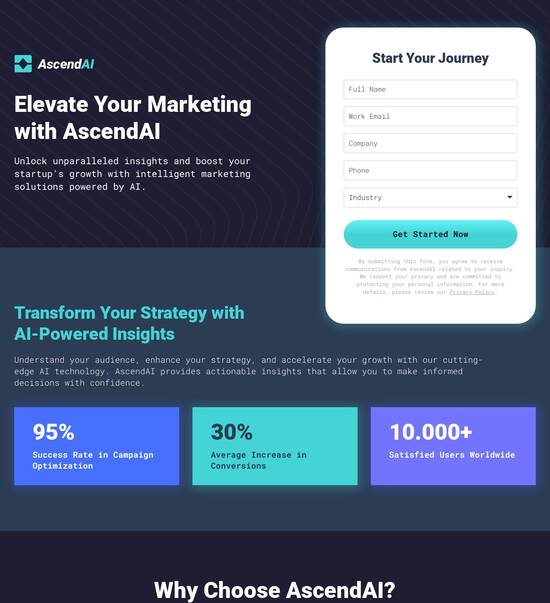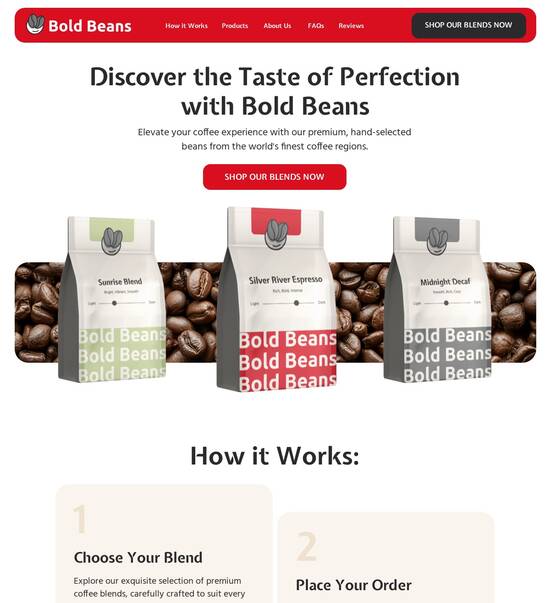
Web page template for E-commerce managers
Use TemplateAbout template
Attract clients and showcase your skills with style using our landing page templates for E-commerce managers. Let's convert those visitors into clients!
Recommended templates

Easy to build without coding
With the intuitive drag-and-drop builder, anyone on your team can create high-converting pages without any knowledge of code or design. Make enhancements to your landing page with custom widgets using Javascript, HTML/CSS, or third-party scripts.

Multiple layouts for any industry and goal
Select from 500+ landing page layouts built to boost conversions across industry-specific scenarios. Customize them by adjusting fonts, adding images, and generating on-brand content with the AI assistant. Quickly scale with Instablocks® and Global Blocks that you can save, reuse, and update globally.

Loads fast and looks polished on any device
Every template is responsive, which means they present professionally on any device and load blazingly fast with our Thor Render Engine. You can also power them up with Google AMP technology to deliver an unparalleled mobile experience and drive higher conversions.

Robust analytics & experimentation
Get real-time updates and reporting across all your devices, showing the number of visitors, conversions, cost-per-visitor, and cost-per-lead. Launch AI-powered experiments, run A/B tests, and use heatmaps to analyze user behavior, then optimize your landing page to maximize conversions.







Easy to build without coding
With the intuitive drag-and-drop builder, anyone on your team can create high-converting pages without any knowledge of code or design. Make enhancements to your landing page with custom widgets using Javascript, HTML/CSS, or third-party scripts.
Multiple layouts for any industry and goal
Select from 500+ landing page layouts built to boost conversions across industry-specific scenarios. Customize them by adjusting fonts, adding images, and generating on-brand content with the AI assistant. Quickly scale with Instablocks® and Global Blocks that you can save, reuse, and update globally.
Loads fast and looks polished on any device
Every template is responsive, which means they present professionally on any device and load blazingly fast with our Thor Render Engine.
Robust analytics & experimentation
Get real-time updates and reporting across all your devices, showing the number of visitors, conversions, cost-per-visitor, and cost-per-lead. Launch AI-powered experiments, run A/B tests, and use heatmaps to analyze user behavior, then optimize your landing page to maximize conversions.
All the features you need to build lead-generating landing pages
Explore more featuresLearn how to build top-performing landing pages for any goal
FAQs
Leading the way in building high-performing landing pages





Create high-converting landing pages with Instapage: A step-by-step guide
Building high-converting landing pages is essential for marketers looking to enhance their digital campaigns. Instapage offers an intuitive platform equipped with tools that empower users to create effective landing pages tailored for varied marketing needs. In this guide, we'll walk you through the process of leveraging Instapage to maximize your campaign ROI.
Understanding the Importance of Landing Pages
Landing pages serve as crucial touchpoints for your marketing campaigns, designed to capture leads and drive conversions. With conversion-focused designs, these pages can significantly impact the success of your campaigns. Instapage provides over 100 customizable templates that allow marketers to tailor their content effectively.
- High conversion rates: Quality landing pages optimize user engagement.
- Lead generation: Effective design elements capture user information efficiently.
- A/B testing capabilities: Use Instapage's built-in tools to iterate and improve designs.
Step 1: Selecting the Right Template
Choosing a template is the first step in building a successful landing page. Instapage's library offers a wide array of templates to suit various industries and objectives.
- Find templates that align with your brand: Ensure they reflect your services.
- Consider your target audience: Use designs that resonate with your specific demographic.
- Review performance metrics: Utilize conversion data to choose high-performing templates.
Step 2: Customizing Your Page
Customization is key to creating an engaging user experience. With Instapage’s drag-and-drop functionality, you can effortlessly adjust your page elements.
- Add personalized content: Use dynamic text replacement to resonate with unique audiences.
- Incorporate lead generation forms: Capture user data effectively with built-in fields.
- Use visuals strategically: High-quality images and videos can improve engagement.
Step 3: Optimizing for Conversions
Every landing page needs to be optimized for maximum conversions. Instapage offers powerful tools to analyze and enhance your pages.
- Implement A/B testing: Experiment with different designs and copy to find what works best.
- Use heatmaps: Analyze user behavior to understand where visitors are clicking.
- Monitor performance metrics: Regularly check analytics dashboards to track and tweak performance.
In conclusion, utilizing Instapage can transform your approach to creating landing pages, significantly impacting your digital marketing outcomes. By following these steps, you can maximize your investment and ensure your campaigns are as effective as possible.
Ready to take your landing pages to the next level? Start your journey with Instapage today and watch your conversion rates soar!
People also ask about Web page template for E-commerce managers
Web page template for e-commerce managers
The evolution of e-commerce web page templates
E-commerce has undergone significant transformations since its inception. In the early days, simple HTML pages dominated the space, focusing primarily on product listings without much thought given to user experience. As the internet matured, so did the understanding of consumer needs. E-commerce platforms began to integrate graphics, improved layouts, and essential navigation tools that prioritized an engaging shopping experience. This evolution transformed templates into sophisticated tools capable of driving sales through enhanced user interfaces.
The advent of responsive design marked another major leap forward. Responsive design ensures that e-commerce sites offer optimal viewing experiences across various devices, particularly smartphones and tablets, which have surged in popularity. A 2019 study indicated that over 50% of global web traffic comes from mobile devices. Consequently, the importance of mobile optimization within web page templates has escalated, directly influencing consumer behavior and significantly boosting conversion rates.
Key features of e-commerce web page templates
Several critical features set e-commerce web page templates apart from standard website designs. First and foremost is customizability. Effective templates provide managers with the tools to tailor designs, ensuring they reflect the brand's unique identity. This customization can range from choosing color palettes and fonts to arranging elements in a way that resonates with the target audience. Modern templates often include drag-and-drop interfaces, empowering users to make adjustments without requiring coding experience.
Integration capabilities follow closely as a primary factor. E-commerce managers need to connect with various essential tools, such as payment gateways, customer relationship management (CRM) systems, and inventory management tools. Templates that allow for seamless API integrations can streamline operations significantly, helping reduce manual work and errors. Additionally, built-in SEO optimization features are invaluable, enabling managers to enhance their search visibility and drive traffic organically.
Customizability enables brand alignment
Integration capabilities ensure operational efficiency
SEO optimization features enhance search visibility
Fast loading times improve user experience
The benefits of using e-commerce templates for managers
Utilizing e-commerce templates offers invaluable benefits for managers who aim to streamline their business processes. One prominent advantage lies in time efficiency; these templates drastically reduce deployment times for new products. Instead of dedicating resources to intricate coding and design, teams can focus on strategic aspects of business development. This not only enhances productivity, but also allows e-commerce managers to respond quicker to market demands.
Cost-effectiveness is another key benefit. In many cases, e-commerce templates require minimal developer involvement, which can lead to significant savings. Plus, many companies offer discounts on custom themes, further lowering upfront costs. Importantly, enhanced customer experiences are a direct result of these templates. Features like intuitive navigation and integrated customer engagement tools—such as live chat and customer reviews—create a more enjoyable shopping experience, encouraging repeat business.
Innovative themes shaping e-commerce trends
As e-commerce continues to evolve, several innovative themes are emerging to capture consumer attention. Trend-focused templates adapt to seasonal sales and promotions, keeping the online store fresh and relevant. These templates also often incorporate social proof elements such as user-generated content and testimonials, which can significantly boost consumer trust and credibility in the brand.
Niche market templates are gaining traction as well. These templates cater specifically to industries, such as fashion or electronics, and ensure that the design and functionality align with customer expectations within those sectors. While selecting a template, it is essential for e-commerce managers to consider branding strategy, as a cohesive brand image can dramatically influence consumer perception and purchasing decisions.
Harnessing the power of page builders for optimization
The proliferation of page builders has transformed how e-commerce managers create and optimize their websites. An intuitive design process eliminates the need for extensive coding knowledge, allowing teams to focus on aesthetics and user experience. Furthermore, built-in A/B testing capabilities enable managers to assess different design variations and optimize for higher conversion rates effectively—an invaluable feature for maximizing the performance of landing pages.
Collaboration among team members is another advantage brought forth by page builders. By fostering workflows that unite marketing and engineering efforts, e-commerce managers can develop more effective and strategic online platforms. This collaborative approach encourages iterative design based on team feedback, ensuring that the final product not only meets technical requirements but also resonates with the target audience.
Overcoming common challenges in e-commerce management
While e-commerce managers benefit from using web page templates, they still face common challenges. One such challenge involves managing spam and security issues effectively. Implementing anti-spam strategies for customer interactions is crucial, as malicious content can tarnish a brand's reputation. Moreover, adhering to best practices for secure transactions is vital for protecting sensitive customer data and building trust.
Another challenge is dealing with customer overwhelm, especially during high-traffic events such as sales or holidays. Strategies can include organizing user flow efficiently and utilizing customer support solutions like chatbots to handle inquiries during peak times. These solutions ensure customer service remains consistent, helping to maintain a positive shopping experience even in busy periods.
Future trends in e-commerce templates
Looking ahead, personalization and custom user experiences are becoming increasingly critical in the world of e-commerce. AI-driven insights will greatly inform template design decisions, allowing e-commerce managers to provide tailored experiences based on user behavior. Adaptive templates will evolve to respond dynamically, ensuring that each visitor encounters a personalized interface that resonates with their needs.
Sustainability will also play a key role in future e-commerce template trends. As consumers become more environmentally conscious, the demand for eco-friendly e-commerce solutions is on the rise. This shift suggests that templates designed with sustainability in mind will attract consumers who prioritize greener shopping choices, making it essential for brands to incorporate eco-friendly design elements into their strategies.
Success stories: brands leveraging e-commerce templates
Several brands have successfully leveraged e-commerce templates to transform their online presence. Notable case studies include companies that reported significant increases in conversion rates after implementing optimized templates tailored to their branding and audience. By analyzing key metrics before and after the switch to custom e-commerce templates, many brands witnessed substantial growth in sales and customer engagement.
Lessons learned from these industry leaders emphasize the importance of scalability as a core principle for rapid growth. By selecting adaptable templates, brands can adjust their online presence based on evolving market trends. Additionally, a customer-centric approach in design not only enhances user experience but also fosters loyalty, making it an essential focus in template selection.
Ready to skyrocket conversions?
Supercharge your ad campaigns with high-performing landing pages
Get started














